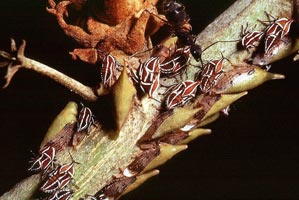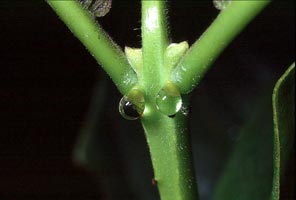|
|
|||||||||||||||||||
 | Atividades de Ensino |
|
Graduação Ecologia Animal Ciências do Ambiente Introdução à Ecologia Etologia Ecologia Geral Ecologia Básica |
Pós-Graduação Ecologia de Populações Ecologia de Comunidades e Ecossistemas Ecologia de Campo II Biologia Comportamental de Artrópodos Ecologia Comportamental |
 | Atividades de Orientação em Pesquisa |
1 - Inara Roberta Leal - Ecologia comportamental de Pachycondyla
(=Termitopone) marginata (Roger) (Hymenoptera: Formicidae): Predação
em grupo e hábito migratório. Tese de Mestrado, Pós-Graduação em Ecologia,
Universidade Estadual de Campinas. 1994
2 - Sirayama de Oliveira Ferreira - Nectários extraflorais de Ouratea
spectabilis (Ochnaceae) e a fauna de formigas associadas: um
estudo em vegetação de cerrado no sudeste do Brasil. Tese de Mestrado,
Pós-Graduação em Ecologia, Universidade Estadual de Campinas. 1994
3 - André V. L. Freitas - Biologia e ecologia de Eunica bechina
(Lepidoptera: Nymphalidae), e sua interação com formigas em Caryocar
brasiliense (Caryocaraceae). Tese de Mestrado, Pós-Graduação
em Ecologia, Universidade Estadual de Campinas. 1994
4 - Flávia N. S. Medeiros - Ecologia comportamental da formiga neotropical
Pachycondyla striata em uma floresta semidecídua em Campinas,
São Paulo. Tese de Mestrado, Pós-Graduação em Ecologia, Universidade
Estadual de Campinas. 1997
5 - Marcio R. Pie - Ecologia comportamental de Ectatomma opaciventre
(Formicidae, Ponerinae): Forrageamento e organização social. Tese
de Mestrado, Pós-Graduação em Ecologia, Universidade Estadual de Campinas.
1998
6 - Rafael Xavier de Camargo - Ecologia e comportamento social da
formiga arborícola Odontomachus hastatus (Hymenoptera: Formicidae:
Ponerinae). Tese de Mestrado, Pós-Graduação em Ecologia, Universidade
Estadual de Campinas. 2002
7 - Tiago B. Quental - Associação condicional entre o homóptero Guayaquila
xiphias (Membracidae) e suas formigas atendentes: O efeito da
fenologia da planta no resultado da interação. Tese de Mestrado, Pós-Graduação
em Ecologia, Universidade Estadual de Campinas. 2002
8 - Rodrigo Cogni - Forrageamento da formiga arborícola Gnamptogenys
moelleri (Forel) (Ponerinae: Ectatommini): Ritmo de atividade,
dieta e área de vida. Tese de Mestrado, Pós-Graduação em Ecologia,
Universidade Estadual de Campinas. 2003
9 - Humberto P. Dutra - Interações entre formigas e frutos de Urera
baccifera numa mata tropical. Tese de Mestrado, Pós-Graduação
em Ecologia, Universidade Estadual de Campinas. 2004
10 - Alice Moraes - Biologia e ecologia de Pleuroptya silicalis
(Lepidoptera: Crambidae) e Urbanus esmeraldus (Lepidoptera:
Hesperiidae): táticas defensivas e interações
com formigas em arbustos de Urera baccifera (Urticaceae). Tese de
Mestrado, Pós-Graduação em Ecologia, Universidade
Estadual de Campinas. 2006 (Co-orientador: A.V.L. Freitas).
11 - Sebastián F. Sendoya - Ecologia comportamental na interface inseto-planta:
padrões de oviposição na borboleta Eunica
bechina em uma planta visitada por formigas. Tese de Mestrado,
Pós-Graduação em Ecologia, Universidade Estadual
de Campinas. 2007 (Co-orientador: A.V.L. Freitas).
12 - Henrique Silveira - Interações entre formigas,
o membracídeo Guayaquila xiphias (Hemiptera) e sua
planta hospedeira Schefflera vinosa (Araliaceae): O papel
dos lipídeos cuticulares na camuflagem química dos membracídeos
(Araliaceae). Tese de Mestrado, Pós-Graduação
em Ecologia, Universidade Estadual de Campinas. 2008 (Co-orientador:
J.R. Trigo).
13 - Pedro Rodrigues - Estudo experimental sobre orientação e marcação de ninho na formiga arbórea Odontomachus hastatus (Formicidae: Ponerinae). Tese de Mestrado, Pós-Graduação em Ecologia, Universidade Estadual de Campinas. 2009
14 - Daniel de Paiva Silva - História Natural de Edessa rufomarginata De Geer (Hemiptera: Pentatomidae) em vegetação de cerrado: Aspectos biológicos, ecológicos e comportamentais de um percevejo-do-mato. Tese de Mestrado, Pós-Graduação em Ecologia, Universidade Estadual de Campinas. 2010
15 - Danilo Muniz – Composição e sazonalidade de borboletas frugívoras no cerrado, com ênfase na relação fenológica entre Eunica bechina (Nymphalidae: Biblidinae) e sua planta hospedeira Caryocar brasiliense (Caryocaraceae). Tese de Mestrado, Pós-Graduação em Ecologia, Universidade Estadual de Campinas. 2011
Doutorado
1 - Kleber Del Claro - Ecologia da interação entre formigas e Guayaquila
xiphias (Homoptera: Membracidae) em Didymopanax vinosum
(Araliaceae). Tese de Doutorado, Pós-Graduação em Ecologia, Universidade
Estadual de Campinas. 1995
2 - Inara Roberta Leal - Ecologia e história natural de formigas Attini
em vegetação de cerrado. Tese de Doutorado, Pós-Graduação em Ecologia,
Universidade Estadual de Campinas. 1998
3 - Marco Aurélio Pizo - Interação formiga-planta em solo de Mata
Atlântica: influência de formigas na ecologia de frutos e sementes
não-mirmecocóricas. Tese de Doutorado, Pós-Graduação em Ecologia,
Universidade Estadual de Campinas. 1998
4 - Luciana Passos - Ecologia da interação entre formigas, frutos
e sementes em solo de mata de restinga. Tese de Doutorado, Pós-Graduação
em Biologia Vegetal, Universidade Estadual de Campinas. 1998
5 - Jarbas Queiroz - Interações entre formigas e Aleyrothrixus
aepim (Homoptera: Aleyrodidae) e seus efeitos sobre insetos desfolhadores
em Croton (Euphorbiaceae). Tese de Doutorado, Pós-Graduação em Ecologia,
Universidade Estadual de Campinas. 2001
6 - Glauco Machado - Ecologia comportamental e história natural de
opiliões (Arachnida: Opiliones): Defesa, socialidade e investimento
parental. Tese de Doutorado, Pós-Graduação em Ecologia, Universidade
Estadual de Campinas. 2002
7- Alexander Christianini - Interação entre formigas, frutos e sementes
em solo de cerrado: o papel de formigas na biologia de sementes e
plântulas. Tese de Doutorado, Pós-Graduação em Ecologia, Universidade
Estadual de Campinas. 2007
8 - Claudia Bottcher - O consumo de sementes e frutos carnosos por formigas em mata Atlântica: História natural, ecologia e variação espacial de uma interação proeminente. Tese de Doutorado, Pós-Graduação em Ecologia, Universidade Estadual de Campinas. 2010
9 - Ana Gabriela D. Bieber - A fragmentação florestal e a interação entre formigas e diásporos carnosos na floresta Atlântica. Tese de Doutorado, Pós-Graduação em Ecologia, Universidade Estadual de Campinas. 2012
 | Corpo Editorial de Revistas Científicas |

|
|
 | Áreas de Pesquisa |

A expressiva dominância de formigas no solo e sobre a vegetação abriu caminho para a evolução de diversos tipos de associações mutualísticas entre formigas e plantas superiores, especialmente em ambientes tropicais. Em diversas dessas associações as formigas podem exercer um efeito benéfico sobre as plantas, reduzindo o dano causado por herbívoros, promovendo a dispersão e/ou germinação de sementes, ou mesmo facilitando a absorção de nutrientes pela planta. Por outro lado, as formigas podem também exercer efeitos negativos sobre plantas através da predação direta de sementes, ou pelo corte de material vegetal para o cultivo de fungos.
As linhas de pesquisa desenvolvidas por nosso grupo na área de História Natural, Ecologia e Comportamento de Formigas Tropicais abrangem três frentes principais:
(1) Interações planta-herbívoro-formiga
(2) Ecologia comportamental de formigas
(3) Interações entre formigas e sementes
Estas linhas de investigação incluem colaborações ativas com pesquisadores de outras universidades brasileiras e do exterior, e envolvem observações e experimentos no campo e em laboratório.
 | Principais Publicações |
 |
 |
Oliveira, P.S. & Marquis, R.J. 2002 (Editores). The Cerrados of Brazil: Ecology and Natural History of a Neotropical Savanna. 398 pp. Columbia University Press, NY. >> link para o livro |
Artigos em Periódicos e Capítulos de Livros [Lista
completa]
Oliveira, P.S. & Sazima, I. 1984.
The adaptive bases of ant-mimicry in a neotropical aphantochild spider
(Araneae: Aphantochilidae). Biological Journal of the Linnean
Society, 22: 145-155. [PDF]
Oliveira, P.S. & Leitão-Filho, H.F. 1987. Extrafloral nectaries:
Their taxonomic distribution and abundance in the woody flora of cerrado
vegetation in Southeast Brazil. Biotropica, 19: 140-148. [PDF]
Oliveira, P.S., Silva, A.F. da & Martins, A.B. 1987. Ant foraging on extrafloral nectaries of Qualea grandiflora (Vochysiaceae) in cerrado vegetation: ants as potential antiherbivore agents. Oecologia 74: 228-230. [PDF]
Oliveira, P.S. 1988. Ant-mimicry in some Brazilian salticid and clubionid spiders (Araneae: Salticidae, Clubionidae). Biological Journal of the Linnean Society, 33: 1-15. [PDF]
Oliveira, P.S. & Hölldobler, B. 1989. Orientation and communication in the Neotropical ant Odontomachus bauri Emery (Hymenoptera, Formicidae, Ponerinae). Ethology, 83: 154-166.
Oliveira, P.S. & Hölldobler, B. 1990. Dominance orders in the ponerine ant Pachycondyla apicalis (Hymenoptera: Formicidae). Behavioral Ecology and Sociobiology 27: 385-393. [PDF]
Oliveira, P.S. & and Oliveira-Filho, A.T. 1991. Distribution of extrafloral nectaries in the woody flora of tropical communities in Western Brazil. In: Plant-Animal Interactions: Evolutionary Ecology in Tropical and Temperate Regions. P.W. Price, T.M. Lewinsohn, G.W. Fernandes & W.W. Benson (editors). John Wiley & Sons, New York. pp. 163-175.
Oliveira, P.S. & Brandão,
C.R.F. 1991. The ant community associated with extrafloral nectaries
in Brazilian cerrados. In: Ant-Plant Interactions. Cutler, D.F. &
Huxley, C.R. (editors). Oxford University Press, Oxford. pp. 198-212.
Del Claro, K. & Oliveira, P.S. 1993. Ant-homoptera interaction:
do alternative sugar sources distract tending ants? Oikos
68: 202-206. [PDF]
Leal, I.R. & Oliveira, P.S. 1995. Behavioral ecology of the neotropical termite-hunting ant Pachycondyla (=Termitopone) marginata: colony founding, group-raiding and migratory patterns. Behavioral Ecology and Sociobiology 37: 373-383. [PDF]
Hölldobler, B., Janssen, E., Bestmann,
H.J., Leal, I.R., Oliveira, P.S., Kern, F., König, W.A. 1996. Communication
in the migratory termite-hunting ant Pachycondyla (=Termitopone) marginata (Formicidae, Ponerinae). Journal of Comparative Physiology
178: 47-53. [PDF]
Freitas, A.V.L. & Oliveira, P.S. 1996. Ants as selective agents
on herbivore biology: effects on the behaviour of a non-myrmecophilous
butterfly. Journal of Animal Ecology 65: 205-210. [PDF]
Del-Claro, K. & Oliveira, P.S. 1996. Honeydew flicking by treehoppers provides cues to potential tending ants. Animal Behaviour 51: 1071-1075. [PDF]
Oliveira, P.S. 1997. The ecological function of extrafloral nectaries: herbivore deterrence by visiting ants and reproductive output in Caryocar brasiliense (Caryocaraceae). Functional Ecology 11: 323-330. [PDF]
Castanho, L.M. & Oliveira, P.S. 1997. Biology and behaviour of the neotropical ant-mimicking spider Aphantochilus rogersi (Araneae: Aphantochilidae): nesting, maternal care and ontogeny of ant-hunting techniques. Journal of Zoology 242: 643-650.
Leal, I.R. & Oliveira, P.S. 1998. Interactions Between Fungus-Growing Ants (Attini), Fruits and Seeds in Cerrado Vegetation in Southeast Brazil. Biotropica 30: 170-178. [PDF]
Pizo, M.A. & Oliveira, P.S. 1998. Interaction between ants and seeds of a nonmyrmecochorous neotropical tree, Cabralea canjerana (Meliaceae), in the Atlantic forest of Southeast Brazil. American Journal of Botany 85: 669-674. [PDF]
Oliveira, P.S., Rico-Gray, V., Díaz-Castelazo, C, & Castillo-Guevara, C. 1999. Interaction between ants, extrafloral nectaries, and insect herbivores in Neotropical coastal sand dunes: Herbivore deterrence by visiting ants increases fruit set in Opuntia stricta (Cactaceae). Functional Ecology 13: 623-631. [PDF]
Del-Claro, K. & Oliveira, P.S. 2000. Conditional outcomes in a neotropical treehopper-ant association: temporal and species-specific variation in ant protection and homopteran fecundity. Oecologia 124: 156-165. [PDF]
Leal, I.R. & Oliveira, P.S. 2000. Foraging ecology of attine ants in a Neotropical savanna: seasonal use of fungal substrate in the cerrado vegetation of Brazil. Insectes Sociaux 47: 376-382. [PDF]
Pizo, M.A. & Oliveira, P.S. 2000. The Use of Fruits and Seeds by Ants in the Atlantic Forest of Southeast Brazil. Biotropica 32(b): 851-861. [PDF]
Queiroz, J.M. & Oliveira, P.S. 2001. Tending ants protect honeydew-producing whiteflies (Homoptera: Aleyrodidae). Environmental Entomology 30: 295-297. [PDF]
Pizo, M.A. & Oliveira, P.S. 2001. Size and lipid content of nonmyrmecochorous diaspores: effects on the interaction with litter-foraging ants in the Atlantic rain forest of Brazil. Plant Ecology 157: 37-52. [PDF]
Passos, L. & Oliveira, P.S. 2002. Ants affect the distribution and performance of Clusia criuva seedlings, a primarily bird-dispersed rainforest tree. Journal of Ecology 90: 517-528. [PDF]
Oliveira, P.S., Freitas, A.V.L. & Del-Claro, K. 2002. Ant foraging on plant foliage: contrasting effects on the behavioral ecology of insect herbivores. In: The Cerrados of Brazil: Ecology and Natural History of a Neotropical Savanna. Oliveira, P.S. & Marquis R.J. (editors). Columbia University Press, NY. pp. 287-305. [PDF]
Fourcassié, V. & Oliveira,
P. S. 2002. Foraging ecology of the giant Amazonian ant Dinoponera gigantea (Hymenoptera, Formicidae, Ponerinae): activity schedule, diet, and spatial
foraging patterns. Journal of Natural History 36: 2211-2227.
[PDF]
Passos, L. & Oliveira, P.S. 2003. Interactions between ants, fruits,
and seeds in a restinga forest in south-eastern Brazil. Journal
of Tropical Ecology 19: 261-270. [PDF]
Cogni, R., Freitas, A.V.L., & Oliveira P.S. 2003. Interhabitat differences in ant activity on plant foliage: Ants at extrafloral nectaries of Hibiscus pernambucensis in sandy and mangrove forests. Entomologia Experimentalis et Applicata 107: 125-131. [PDF]
Rico-Gray, V., Oliveira, P.S., Parra-Tabla, V., Cuautle, M. & Díaz-Castelazo, C. 2004. Ant-Plant Interactions: Their Seasonal Variation andEffects on Plant Fitness. In: Coastal Sand Dunes: Ecology and Restoration. Martínez M.L., Psuty, N. & Lubke, R. (editors). Springer-Verlag, Berlin. pp. 221-239. [PDF]
Pizo, M.A., L. Passos & P.S. Oliveira. 2005. Ants as seed dispersers of fleshy diaspores in Brazilian Atlantic forests. In: Seed fate: Predation and secondary dispersal. P.-M. Forget, J. E. Lambert, P. E. Hulme & S. B. Vander Wall (editors.). CABI Publishing, Wallingford, Oxfordshire, UK. pp 315-329. [PDF]
Cogni, R. & Oliveira P.S. 2004. Patterns in foraging and nesting ecology in the neotropical ant Gnamptogenys moelleri (Formicidae, Ponerinae). Insectes Sociaux 51:123-130. [PDF]
Passos, L. & Oliveira, P.S. 2004. Interaction between ants and fruits of Guapira opposita (Nyctaginaceae) in a Brazilian sandy plain rainforest: ant effects on seeds and seedlings. Oecologia 139: 376-382. [PDF]
Cogni, R. & Oliveira P.S. 2004. Recruitment behavior during foraging in the neotropical ant Gnamptogenys moelleri (Formicidae: Ponerinae): does the type of food matter. Journal of Insect Behavior 17:443-458. [PDF]
Oliveira, P.S. & Freitas A.V.L. 2004. Ant-Plant-Herbivore Interactions in the Neotropical Cerrado Savanna. Naturwissenschaften 91:557-570. [PDF]
Díaz-Castelazo, C., V. Rico-Gray, P.S. Oliveira & M. Cuautle. 2004. Extrafloral nectary-mediated ant-plant interactions in the coastal vegetation of Veracruz, Mexico: Richness, occurrence, seasonality and ant foraging patterns. Ecoscience 11:472-481. [PDF]
Oliveira, P.S. & Del-Claro, K. 2005. Multitrophic interactions in a neotropical savanna: Ant-hemipteran systems, associated insect herbivores, and a host plant. In: Biotic Interactions in the Tropics. Burslem, DFRP, Pinard, MA & Hartley, SE (editors). Cambridge University Press, Cambridge, UK. pp. 414-438. [PDF]
Pizo, M.A., P.R. Guimarães, Jr. & P.S. Oliveira. 2005. Seed removal by ants from faeces produced by different vertebrate species. Ecoscience 12:136-140. [PDF]
Quental, T.B., J.R. Trigo & P.S.
Oliveira. 2005. Host-Plant Flowering Status and Sugar Concentration
of Phloem Sap: Effects on an Ant-Treehopper Interaction. European
Journal of Entomology 102:201-208. [PDF]
Dutra, H.P, Freitas, A.V.L., & Oliveira P.S. 2006. Dual ant attraction
in the Neotropical shrub Urera baccifera (Urticaceae): the role of ant
visitation to pearl bodies and fruits in herbivore deterrence and leaf
longevity. Functional Ecology 20:252-260. [PDF]
Christianini, A.V, Mayhé-Nunes, A.J. & Oliveira P.S. 2007.
The role of ants in the removal of non-myrmecochorous diaspores and
seed germination in a Neotropical savanna. Journal of Tropical Ecology 23:343-351. [PDF]
Guimarães Jr., P.R., Rico-Gray,
V., Oliveira, P.S., Izzo, T.J., dos Reis, S.F. & Thompson, J.N.
2007. Interaction intimacy affects structure and coevolutionary dynamics
in mutualistic networks. Current Biology 17:1-7. [PDF]
[PDF-supll]
Machado, S.R., Morellato, L.P.C., Sajo, M.G., & Oliveira, P.S. 2008.
Morphological patterns of extrafloral nectaries in woody plant species
of the Brazilian cerrado. Plant Biology 10: 660-673.
[PDF]
Kaminski, L. A., Sendoya, S.F., Freitas,
A.V.L., & Oliveira, P.S. 2009. Ecologia comportamental na interface
formiga-planta-herbívoro: Interações entre formigas
e lepidópteros. Oecologia Brasiliensis
13:27-44. [PDF]
Medeiros, F.N.S. & Oliveira, P.S. 2009. Season-Dependent Foraging
Patterns: Case Study of a Neotropical Forest-Dwelling Ant (Pachycondyla
striata; Ponerinae). In: Food Exploitation by Social Insects: Ecological,
Behavioral, and Theoretical Approaches. S. Jarau & M. Hrncir (editores).
CRC Press, Taylor and Francis Group, Boca Raton, USA.
pp. 81-95. [PDF]
Christianini, A.V . & Oliveira, P.S. 2009. The relevance of ants
as seed rescuers of a primarily bird-dispersed tree in the neotropical
cerrado savanna. Oecologia 160:735–745. [PDF]
Raimundo, R. L. G., Freitas, A.V.L., & Oliveira, P.S. 2009. Seasonal
patterns in activity rhythm and foraging ecology in the Neotropical
forest-dwelling ant, Odontomachus chelifer (Formicidae: Ponerinae).
Annals of the Entomological Society of America 102:1151-1157.
[PDF]
Sendoya, S.F., Freitas, A.V.L., & Oliveira, P.S. 2009. Egg-laying
butterflies distinguish predaceous ants by sight. American Naturalist
174:134-140. [PDF]
Silveira, H.C.P., Oliveira, P.S., & Trigo, J.R. 2010. Attracting predators without falling prey: Chemical camouflage protects honeydew-producing treehoppers from ant predation. American Naturalist 175:261-268. [PDF]
Christianini, A.V . & Oliveira, P.S.
2010. Birds and ants provide complementary seed dispersal in a neotropical
savanna. Journal of Ecology 98:573–582. [PDF]
Schoereder, J.H., Sobrinho, T.G., Madureira, M.S., Ribas, C.R., &
Oliveira, P.S. 2010. The arboreal ant community visiting extrafloral
nectaries in the Neotropical cerrado savanna. Terrestrial Arthropod
Reviews 3:3-27. [PDF]
Rodrigues, D., Kaminski, L.A., Freitas,
A.V.L., & Oliveira, P.S. 2010. Trade-offs underlying polyphagy in
a facultative ant-tended florivorous butterfly: the role of host plant
quality and enemy-free space. Oecologia 163:719-728. [PDF]
Kaminski, L.A., Freitas, A.V.L., & Oliveira, P.S. 2010. Interaction
between mutualisms: Ant-tended butterflies exploit enemy-free space
provided by ant-treehopper associations. American Naturalist
176:322-334. [PDF]
Silva, D.P. & Oliveira, P.S. 2010. Field biology of Edessa rufomarginata (Hemiptera: Pentatomidae): Phenology, behavior, and patterns of host
plant use. Environmental Entomology 39:1903-1910. [PDF]
Oliveira, P. S., Camargo, R. X. & Fourcassié, V. 2011. Nesting patterns, ecological correlates of polygyny and social organization in the neotropical arboreal ant Odontomachus hastatus (Formicidae, Ponerinae). Insectes Sociaux 58:207–217. [PDF]
Leal, I. R.; Silva, P. S. D., & Oliveira, P.S. 2011. Natural history and ecological correlates of fungus-growing ants (Formicidae: Attini) in the Neotropical cerrado savanna. Annals of the Entomological Society of America 104: 910-908. [PDF]
Oliveira, P.S., Sendoya S.F., & Del-Claro, K. 2012. Defesas bióticas contra herbívoros em plantas do Cerrado: Interações entre formigas, nectários extraflorais e insetos trofobiontes. In: Ecologia das Interações Plantas-Animais: Uma Abordagem Ecológico-Evolutiva. K. Del-Claro & H. M. Torezan-Silingardi. (Editores). Rio de Janeiro: Technical Books. pp. 155-168.
Christianini, A. V., Mayhé-Nunes, A. J., & Oliveira, P.S. 2012. Exploitation of Fallen Diaspores By Ants: Are There Ant-Plant Partner Choices? Biotropica (in press). [PDF]
Camargo, R. X. & Oliveira, P.S. 2012. Natural history of the Neotropical arboreal ant, Odontomachus hastatus (Formicidae, Ponerinae): Nest sites, foraging schedule, and diet. Journal of Insect Science (in press).
Moraes, A., Greeney H. F., Oliveira, P.S., Barbosa E. P., Freitas, A. V. L. 2012. Morphology and behavior of the early stages of the skipper Urbanus esmeraldus on an ant-visited host plant, Urera baccifera. Journal of Insect Science (in press).
Bächtold, A., Del-Claro, K., Kaminski, L. A., Freitas, A. V. L., & Oliveira, P. S. 2012. Natural history of an ant-plant-butterfly interaction in a Neotropical savanna. Journal of Natural History (in press).


